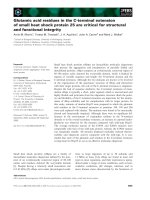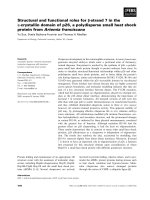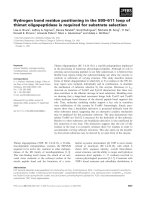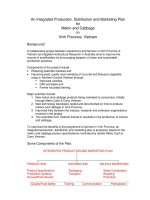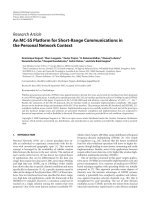Organizing marketing activities for Vietnamese-Owned automobile assemblers in the present development process of Vietnamese economy
Bạn đang xem bản rút gọn của tài liệu. Xem và tải ngay bản đầy đủ của tài liệu tại đây (2.65 MB, 124 trang )
ĐẠI HỌC QUỐC GIA HÀ NỘI
TRƯỜNG ĐẠI HỌC KINH TẾ
ĐỖ VIẾT DƯƠNG
ORGANIZING MARKETING ACTIVITIES FOR
VIETNAMESE-OWNED AUTOMOBILE ASSEMBLERS IN THE
PRESENT DEVELOPMENT PROCESS OF VIETNAMESE
ECONOMY
LUẬN VĂN THẠC SĨ QUẢN TRỊ KINH DOANH
NGƯỜI HƯỚNG DẪN KHOA HỌC: TS. Nguyễn Ngọc Anh
Th.S Nguyễn Việt Anh
Hà Nội – 2007
ĐẠI HỌC QUỐC GIA HÀ NỘI
TRƯỜNG ĐẠI HỌC KINH TẾ
ĐỖ VIẾT DƯƠNG
ORGANIZING MARKETING ACTIVITIES FOR
VIETNAMESE-OWNED AUTOMOBILE ASSEMBLERS IN THE
PRESENT DEVELOPMENT PROCESS OF VIETNAMESE
ECONOMY
Chuyên ngành: Quản trị kinh doanh
Mã số: 60 34 05
LUẬN VĂN THẠC SĨ QUẢN TRỊ KINH DOANH
NGƯỜI HƯỚNG DẪN KHOA HỌC: TS. Nguyễn Ngọc Anh
Th.S Nguyễn Việt Anh
Hà Nội – 2007
vii
TABLE OF CONTENTS
Abstract………………………………….………………………………… …… i
Tóm tắt: iii
Acknowledgments…………………………………………….………………….v
Abbreviation & Acronyms …………………………………………………… vi
Table of contents…………………… vii
Introduction 1
Chapter 1: Literature review 5
1.1. Marketing definition and its basic concepts 5
1.1.1. Definition of Automobile marketing 5
1.1.2. Fundamental concepts 5
1.1.3. The development process of automobile marketing 7
1.1.4. Distinguishing marketing orientation and non-marketing
orientation company 10
1.2. Environmental marketing of VAAs in the market economic
conditions 12
1.2.1. Macro-Environment factors 12
1.2.2. Integrated factors for successful marketing of VAAs 14
1.2.3. Creating value, satisfaction, conserving customer in VAAs 14
1.3. Ascertaining the marketing activities contents for VAAs 22
1.3.1. Models and marketing management contents for VAAs in
currently market. 22
1.3.2. The necessary and principles to evaluate the rational organizing
marketing activities in VAAs 34
Conclusion: 35
viii
Chapter 2 : Current status of organizing marketing activities of
automobile assemblers in Vietnam 36
2.1. The development process of Vietnamese automobile industry 36
2.1.1. Introduction 36
2.1.2. Characteristics 38
2.1.3. Vietnam Automobile Manufacturers Association (VAMA) 38
2.2. Market status review 40
2.2.1. Automobile market analysis 40
2.3. Current status of organizing marketing activities of local
automobile assemblers in Vietnam 46
2.3.1. Marketing in Vietnam and Marketing in automobile industry 46
2.3.2. Appraising the marketing activities of FAAs 47
2.3.3. Appraising the marketing activities of VAAs 62
Conclusion 71
Chapter 3: Solutions for improving marketing activities in VAAs 72
3.1.1. The changes in Macro-Environment and opportunities, challenges
for local Vietnam automobile assemblers. 72
3.1.2. The Vietnamese automotive market forecasting by 2010. 77
3.2. Development orientation of Government for automobile industry
in period (2005-2010) and overview 2020 78
3.3. Recommendations for improving the organizing marketing
activities for Vietnamese-owned automobile assemblers 83
3.3.1. Improving the marketing research, marketing analysis and
building marketing information system for VAAs. 83
3.3.2. Improving the organizing target marketing for VAAs 88
ix
3.3.3. Improving the organizing marketing mix for VAAs 89
3.3.4. Improving the organizing marketing resources of VAAs 96
3.4. The requests for government policies 98
3.4.1. Improving legally environment 98
3.4.2. Improving Infrastructure and Motorization 98
3.4.3. Improving state management for auto industry 99
3.5. The requests for VAAs 101
3.5.1. Sales and distribution 101
3.5.2. After-sales service 102
Conclusion 102
Conclusion 104
References
Appendix
vi
Abbreviation & Acronyms
AFTA : ASEAN Free Trade Area
ASEAN : Association of Southeast Asian nations
CBU : Complete Built-Up
CEPT : Common Effective Preferential Tariff
CKD : Complete Knock Down
FAAs : Foreign – Owned Automobile Assemblers
FPT : FPT Corporation
GDP : Gross Domestic Product
IKD : Incomplete Knock Down
LAVVs : Local Vietnamese Automobile Assemblers
MIS : Marketing Information System
PM : Primer Minister
PR : Public Relationship
R&D : Research and Development
SCT : Special Consumption Tax
SOEs : State-Owned Enterprises
TVC : Television Commerce
USA : United States of America
VAAs : Vietnamese-Owned Automobile Assemblers
VAMA : Vietnam Automobile manufacturers’ Association
VAT : Value Added Tax
VNPT : Vietnam Posts and Telecommunications Corporation
WTO : World Trade Organization
x
List of Tables
Chapter 1
Table:
1.1 Types of marketing control……………………………………………… 33
Chapter 2
Table:
2.1. VAMA’s members list……………………………………………… ….…39
2.2. Evaluation from customer about marketing activities of FAAs …47
2.3. Compare price …………………………………….……………….……….52
2.4. Number of authorized dealers for each auto makers………………… 55
2.5. Evaluating for marketing management of FAAs …………… ………55
2.6. Evaluation from customer about marketing activites of VAAs………62
2.7. List if Vechicle models and agency number of VAAs………………… 64
2.8. Evaluating for marketing management of FAAs …………… ………67
Chapter 3
Table:
3.1. Remarkable achievements in economic growth and macro-economic
(2001-2005)…………………… …………………………………………………75
3.2. Automobile output plan in 2005, 2010 and 2020……………………… 79
3.3. Balancing ability, demand and supplementing automobile output up
to 2010…………………………………………………………… ………………80
3.4. Segment by models……………………………………………… ……….88
xi
List of Figures
Chapter 1
Figure:
1.1. Steps of building plan according to non-marketing orientation………10
1.2. The building process of plan according to marketing orientation.… 11
1.3. Customer’s satisfaction, customer loyalty, value added for customer.15
1.4. Porter's Generic Value Chain………………………………….……… 17
1.5. The Value System………………………………………………………… 21
1.6. SWOT analysis fits into a strategic situation analysis…………… 24
1.7. Steps in segmentation process, market positioning……………… … 25
1.8. Marketing mix and target marke………… ……………………… … 27
Chapter 2
Figure:
2.1. Sales of automobile volume by years 42
2.2 . Sales record by months up to October, 2005 42
2.3. Market share in 2005 and 2006 ……………………………… ……… 43
2.4. Perceived quality of automotive brands ………………………… …….50
2.5. Customer’s opinion of service satisfaction ……………………… … 50
2.6. Price competitive advantage……………… …………………………… 53
Chapter 3
Figure:
3.1. Forecasting the automobile market demand in period 2005-2010 … 77
3.2. SWOT analysis model…… ………………………………………… … 85
3.3. MIS model for VAAs…………………………… …………………… … 86
3.4. Positioning by Auto Brands ……………………………… ………….….89
3.5. Advertising campaign process building…………………………… ……94
1
INTRODUCTION
1. Necessary of the thesis
The development orientation of Government is building the
development automobile industry so that by 2020, it becomes a key industry
of the country, capable of meeting the highest demand of local market and
joining regional and international market.
From the customers expectation that Vietnam will has the developed
automobile market and both model quality, supporting services and
information of them. In addition, with more than 80 million of population,
but scale of automobile market vary small, total sales of VAMA highest in
2003 is 42,556 vehicles, 2004 (40,141) and ten months of 2005 only achieved
28,381 vehicles, thus it is not symmetrical. The knowledge of customers
about the domestic car is very poor, now they are favor import car than
domestic one. So it is a reason for less development of Vietnamese
automotive industry.
From the inefficiently operation of FAAs and we have some new
Vietnamese owned automobile firm join to this market currently, also they
have poor marketing activities both in structure and contents so they did
not gained the high attention of customer even in awareness.
They will face the pressure from the integrated of economy, especially
in given the deadline for AFTA commitment and pending WTO entry,
Vietnam has not much time left to promote the localization program while
few protectionist policies can be implemented.
Thus the scope of thesis I would like to study and propose some new
2
model of organizing marketing activities for VAAs in currently and for next
period. To build Vietnamese brand name and gain more and more in sale
and market share and become the big automobile corporation in Vietnam.
2. Objective of the research
To systematize the basis marketing theory in automobile industry,
research and establish the basis contents of marketing activities for VAAs
now, figure out the role of marketing activities in auto development process
in current Vietnamese automotive market.
To quantitative the result of marketing activities of FAAs and VAAs
achievements, and identify the successes, weaknesses and find the main
reasons to improving.
And then, suggest applied solutions to improving the organizing
strategic marketing for Vietnamese automotive industry up to 2010 and
overview 2020, together submit some requests to government to create favor
environment for these model developing.
3. Key research area
- Object of study: The organizing marketing activities in automobile
industry in generally, and especially in member of VAMA. The main
contents are including organizing the marketing activities and organizing
marketing resources of above object.
- Research area: Automobile assemblers in Hanoi area limited.
4. Methodology
The methodology gives us the guidelines for how we should gather
information for our research and work with it.
- Research problem;
3
With the research areas of “Current Vietnamese automotive
marketing activities” thus and then figure out the improving marketing
activities solution and submit some requests to government to support this
sector.
- Research objective:
Out research purpose is descriptive and analysis the Vietnamese
automotive market and its current marketing activities of FAAs & VAAs in
the future to build develop automobile industry and improving it’s more
competitive in the integrated of Vietnamese economy.
- Research method:
The research approach is qualitative study that helps us deeper
understanding of how important of marketing activities impacts to
automobile industry. We also use quantitative method to choose the sample
size of 100 customers to understand their need is what will they be got from
marketing activities of FAAs & VAAs also evaluate how satisfy of them for
current Vietnamese automotive industry for both products and supporting
services.
- Data collection;
The choice of a data collection method is a critical point research process.
5. Contributions of the thesis
With the purpose to analyze the current Vietnamese automotive
marketing activities in the market the thesis has contributed some new
contributions as follow:
- Analyzing the status of marketing activities in FAAs, concurrently
evaluating the successes and weaknesses, identify the reasons that FAAs
4
must focus on marketing activities for next period.
- A comprehensive realize of role, position, function of marketing in
automobile industry, clarify the natural of objective environment factors
impact to marketing activities, thence ascertain the basis request for a
marketing program to premises for applying in VAAs.
- Establishing the detail content and implemented model of
marketing activities in order to the development trend of automobile
industry in the near future. Also, systematize and develop the theory of
marketing in VAAs in Vietnam now.
6. Thesis structure
Beside introduction and conclusion, the thesis consists 3 chapters:
Chapter1: Literature review is given to providing theories relevant for
automobile marketing activities area.
Chapter 2: Current status of organizing marketing activities in FAAs
& VAAs
Chapter 3: Solutions for improving marketing activities in VAAs
Introduction
Chapter 1
Literature Review
Chapter 2
Current automotive
industry
Chapter 3
Solutions for Improving
Conclusion
5
CHAPTER 1
LITERATURE REVIEW
1.1. Marketing definition and its basic concepts
1.1.1. Definition of Automobile marketing
Macro: Automobile marketing is a structure of organizational system
supply chain of Auto products and its support service to satisfy expect and
demand of customers in the definitive of society-economic system.
Micro: Automobile marketing is the marketing activities system of
automobile manufacturers, auto-distributors, and others marketing
organization. It is marketing activities system of profit organization and
non-profit organization, automobile marketing is understood specially that
it is the control function of auto-manufacturers, the planning, managing
marketing project, price, distribution system, products, services and PR,
advertising< to create the exchange to satisfy for personality and
organizational objectives.
1.1.2. Fundamental concepts
1.1.2.1. Concept and differentiation between demand and expectation
The difference between “demand” and “expectation” is always
getting more attention of marketing in the automobile industry. In the facts,
what are the customers want maybe it is not their need. Demand is defined
that “the deficient impression for something but we are can feeling” and
demand are wants for specific products backed by an ability to pay and it
can be satisfied by marketing activities system of automobile manufacturers.
Expectation is defined that “wish for or aspiration for something”.
6
1.1.2.2. Market demand
Demands, expectation we have just defined above were make clearly
about products, services to satisfy those demands and expectation. So
market demand is the attraction, attention, buying, using or consumption
for products or services that will satisfy the expectation and market
demands.
1.1.2.3. Determine customer and customer satisfaction
Whether the buyer is satisfied after purchase depends on the offer’s
performances in relation to the buyer’s expectations. In general, satisfaction
is a person’s feeling of pleasure or disappointment resulting from
comparing a product’s perceived performance in relation to his or her
expectations.
1.1.2.4. Exchange and transactions
Exchange: This is the core concept of marketing, “is the process of
obtaining a desired product from someone by offering something in return”.
The concept of exchange is including some conditions potential to exist, and
basis for marketing activities later. First, there are at least two parties have
demand were not satisfy. One party maybe the customer are looking for or
desire for an automobile, auto-service or any information related. And other
is the party also looking for customers or providing auto-products. Second,
demand or capability of one party can meet the demand. Third, both parties
must have something to exchange.
Transactions: is a trade of value between two or more parties, it
involves trading goods or services for other goods or services or popular is
the trading goods or service for money. And it also involves several
7
dimensions: at least two things of value, agreed-upon conditions, a time of
agreement, and a place of agreement.
1.1.2.5. Trading
Trading is the personal or organizational activities in co-relationship
with market, it holds that the key to achieving their goals or organizational
goals consists of the company being more effective than competitors in
creating, delivering, and communicating superior customer value to is
chosen target markets. For example: automobile manufacturer want to sell
its products they must through market to find or get in touch with
customers. Thus, the basis concepts of marketing activities are creating
products, integrated market, building business relation, distribution, setting
price, and offer services.
1.1.3. The development process of automobile marketing
In the traditional business, automobile marketing field has old history
of operation so the marketing activities are appear very soon in the world.
1.1.3.1. Production oriented period:
To understanding how automobile marketing develop, we will study
the case of famous auto company: Ford Motor Corporation, the second
biggest auto manufacturer in the world.
Ford Motor Corporation, headquarter office in Detroit, chief city of
US automobile manufacturing industry, and it has been produced
automobile since eighteen century. At that time, the most important
objective of company is the producing automobile with high quality. So that
the revenue they have and customer habit they get depend on the quality of
automobile which Ford was produced.
8
That status also happened with other famous auto manufacturers in
the world. They have just only focused on producing cars with quality but
have not understand what are their customers wants or expects for their
products and desires for their support service.
1.1.3.2. Sales oriented period.
As other traditional enterprises, production oriented period well
operated until the end of eighteen century, early of 19
th
century. But in the
1920s, car was becoming indispensable of the life in the developed countries.
At that time, customers were more flexible, more active, and market was not
focus as before. Thus, for almost company, they changed strategy by
organized or hired big mobile sales teams. Competition is expressed by
capability of building mobile sales teams. And auto manufacturers were not
exceptionable, such as: Ford had been changed their strategy by building
mobile sales teams and in whole US and expending their showroom system.
1.1.3.3. Marketing period.
Marketing oriented period beginning after World War II, in the en of
1940s, many companies recognized that they were the technology
development epoch and have been started with restructuring their economy
after war. In addition, the consumption has recovered by increasing the
demand for goods and services. For many organizations, one of the most
important question that what product or service they should provide at that
time? As new awareness, customers were who oriented for producing
process and distributed resources for the firms.
Hence, automobile manufacture industry was also like others
business field, a same orientation was development follow marketing
9
oriented. Automobile manufacturers may provide big amount of car by
mobilized, distributed resources and restructured producing process. What
the changes of this period through marketing oriented concept. The
marketing orientation were expressed through oriented for developing the
range of cars and supporting services including: marketing service, sales
service, advertising, PR, maintenance service, repair and other promotion
service after sales<This development orientation combine with the
distribution systems has met the market demand and satisfied their
customer.
1.1.3.4. The marketing culture period.
Some companies have achieved the advanced marketing level when
their marketing activities become to a part of corporate culture and
distracted through all level department of corporate. And the marketing
activities now is not only tasks for marketing department, it is effort of all
person in the company.
In this period customer are center for all their activities. Automobile
manufacturers and supplier also recognized that customers are center for all
their activities.
In this period: the marketing oriented concept is evaluated by follow
factors:
- Customer oriented: understanding and thoughtful of target
customers for providing surpassing service for customer
- Competition oriented: define the competitors (Current and
potential) and analysis their strengths, weaknesses and strategy.
10
- Diagonal function integrated: integrating and promoting resources
of company focus on creating the value for customer.
- Strategic management oriented: finding solution for promoting
value by right investment and suitable.
- Profit: having revenue enough to compensate for long -run
expense and satisfy stockholders
- Public oriented: Concentrate on serving long-run benefits of
customers and society.
1.1.4. Distinguishing marketing orientation and non-marketing orientation
company
Nowadays, whereas most of automobile manufacturers operate base
on customer oriented and effort to widen marketing orientation through out
all departments of firm, but in some companies also have the non-marketing
orientation exist on long-run planning. So to understand clearly two
concepts above we can distinguish by building long-run planning process as
follow:
1.1.4.1. Non-marketing orientation
The figure 1.1 as follow describes the steps of building long-run
planning process in the non-marketing orientation company:
Figure 1.1: Steps of building plan according to non-marketing orientation
1. Identify mission and objective
2. Forming Strategy
3. Implementation
4. Marketing
11
In the past, manufacturing car and providing services of VAAs are
usually unprompted, they are all provided depend on the plan which the
government was assigned. In generally, the first step is identifying the
mission and objective of the firm. And then the second step of this process is
building the strategy, this step is very difficult and take more time than
others. Next, the step of applying the strategy that more difficult. Because of
the firm can not know that strategy is favored by customers or not?
1.1.4.2. Marketing orientation
The building plan process according to marketing orientation
completely differentiated with non-marketing orientation as described in
follow model 1.2:
Figure 1.2: The building process of plan according to marketing
orientation
The first step of both models are the same, for every company must
define the clearly their mission and objective. The differentiation appears
from second step, when the market demand is evaluated as the factor effect
Identify Mission and objective
Define requests for advanced different
Evaluate market demand
Building strategy
Test
Implementation
Marketing
12
to activities of company: what model of car is favored by customer currently,
what service is now successful, and how many potential customers in the
future?
1.2. Environmental marketing of VAAs in the market economic conditions
1.2.1. Macro-Environment factors
As however, every marketing strategy has impacted by macro-
environment factors, they are mainly including: political and policy,
economic, social, technological, and competitiveness factors. In basically,
those factors are uncontrolled but they effect to marketing strategy. Base on
macro-environment analysis the automobile manufacturers will find out the
convenient strategy to serving customer and improving position in the
market. We will analyze each of factors as follow:
1.2.1.1. Political and policy factors
This factors include the requests, mechanism with legally and this
factor may analyze base on: political stability, risk of military invasion, legal
framework for contract enforcement, intellectual property protection, trade
regulations & tariffs, favored trading partners, anti-trust laws, pricing
regulations, taxation - tax rates and incentives, wage legislation - minimum
wage and overtime, industrial safety regulations<. must have improved by
government.
1.2.1.2. Social factors
Social factors as demographics, class structure, education, culture
(gender roles, etc.), entrepreneurial spirit, attitudes (health, environmental
consciousness, etc.) leisure interests are must definite it very important in
marketing for automobile.
13
1.2.1.3. Technological factors
Technological factors are decisive factor for automobile industry,
because every automaker must have innovative technology in hand to
compete with others. Technological factors effect to every step to produce
automobile. To evaluate technological factors we can base on some factors as
follow:
Recent technological developments
Technology's impact on product offering
Impact on cost structure
Impact on value chain structure
Rate of technological diffusion
1.2.1.4. Economical factors
Those factors are GDP per person, financial conditions, interest rate
inflation rate, growth rate, labor cost, infrastructure quality< can effect to
investment decision of company.
1.2.1.5. Competitiveness factors
Competitiveness factors are always can not control in every
marketing plan, and marketing plan is built base on these factors exist in the
market
The number of macro-environmental factors is virtually unlimited. In
practice, the firm must prioritize and monitor those factors that influence its
industry. Even so, it may be difficult to forecast future trends with an
acceptable level of accuracy. In this regard, the firm may turn to scenario
planning techniques to deal with high levels of uncertainty in important
macro-environmental variables.
14
1.2.2. Integrated factors for successful marketing of VAAs
To organizing successful marketing activities in the market, we must define
very clear the integrated factors for marketing in the new market or current
period, there are many automakers. There are four integrated factors for
successful marketing of VAAs and described as follow:
- Pressure form market oriented: the first factors that company get
pressure is market oriented, so that every automaker must unity in a
marketing program to get more efficiently. In there, not only senior
management but also every member in company must thoughtfully and
meet the market demand. Every objectives of each department must engage
in target of satisfying customer.
- The ability of satisfy customer and meet the market demand: VAAs
have enough marketer with knowledge and experience to analysis the
market and define the customer needs or demand to serving in carefully.
And also they have got enough budgets for marketing activities and using
efficiently.
- Understanding the market, keen in building and distribute the value
of product or service to customer: they must define “who are their
customers? What do they want or desire for”
- The convenience between activities plan and market demand: at last,
every automaker must have detail marketing plan including strategy and
steps to implement.
1.2.3. Creating value, satisfaction, conserving customer in VAAs
Nowadays, beside the imported car, Vietnam has seventeen
automobile assemblers (including 11 FAAs and 6 VAAs except Honda
15
motors) providing car and their support service in the market so that
customer has many option to choose the products and using service base on
quality, price, delivery< thus get more opportunities selecting, customer
will choose the product which let them get the highest value compare with
their income, price, objective.
Figure 1.3: Customer’s satisfaction, customer loyalty, value added for
customer
1.2.3.1. Customer’s satisfaction
Whether the buyer is satisfied after purchase depends on the offer’s
performance in relation to the buyer’s expectations. In general, satisfaction
is a person’s feeling of pleasure or disappointment resulting from
comparing a product’s perceived performance (or outcome) in relation to his
or her expectations. If the performance falls short of expectations, the
customer is dissatisfied. If the performance matches the expectations, the
customer is satisfied. If the performance exceeds expectations, the customer
is highly satisfied or delighted. Most of automakers provided the basis
satisfaction for customer and they will increase the satisfaction for customer
in yearly.
Customer’s satisfaction
- Providing the
products/services that
customer expect
- Feedback of customer
Customer loyalty
- Conserving customer
- Customer suppose the
solution for improving
products or services
Value added for customer
- Satisfy the demand of
target customer
- Operating more efficiently
than competitors
- Create new value, unique
for customer
16
1.2.3.2. Customer loyalty
In general, when customer get higher satisfaction, the higher rate of
customer loyalty, because of characteristic of automobile industry that the
rate of customer loyalty very high but some research showed that some
company had lose the market share while the customer’s satisfaction very
high. It means that customer loyalty in this industry not only base on
product but also base on the supporting service they provided.
1.2.3.3. Value added for customer
The approach for customer’s satisfaction focuses on finding the way
to satisfy the current customer. And the approach for value added will bring
customer focus on study decision of customer while buy products or using
service. And automakers must answer three questions as follow:
- What are the norms of getting highly appreciate of customer when
buy their car, or competitor car?
- How customer ranks them and their competitor base on norms
effect to buying decision?
- How important of each norm in total value added bring to
customer?
By studying the value added for customer, automakers can improving
their competitive position, conserving and attract more new customer,
increasing profits.
1.2.3.4. Creating satisfaction and value added for customer
In order to understanding more activities, and base on them
automakers can create the competitive advantages. We can divide activities
into small segment which through automakers can create value added, or
17
we can call model value chain. Michael Porter of Harvard proposed the
value chain as a tool for identifying ways to create more customer value
including the same activities in most of business organization. He divided
activities of business organization into two kinds: primary activities and
support activities and described as follow figure:
Figure 1.4: Porter's Generic Value Chain
The goal of these activities is to offer the customer a level of value that
exceeds the cost of the activities, thereby resulting in a profit margin.
The primary value chain activities are:
Inbound Logistics: the receiving and warehousing of raw materials
and their distribution to manufacturing as they are required.
Operations: the processes of transforming inputs into finished
products and services.
Outbound Logistics: the warehousing and distribution of finished
goods.
Marketing & Sales: the identification of customer needs and the
generation of sales.
MARGIN
MARGIN
Procurement
Technology Development
HR Management
Firm Infrastructure
Inbound
Logistics
Operations
Outbound
Logistics
Marketing
&
Sales
Services
Primary Activities
Support Activities



